Agentic CMS: Why Kontent.ai’s Vision for the Future of Content Management is Inspiring
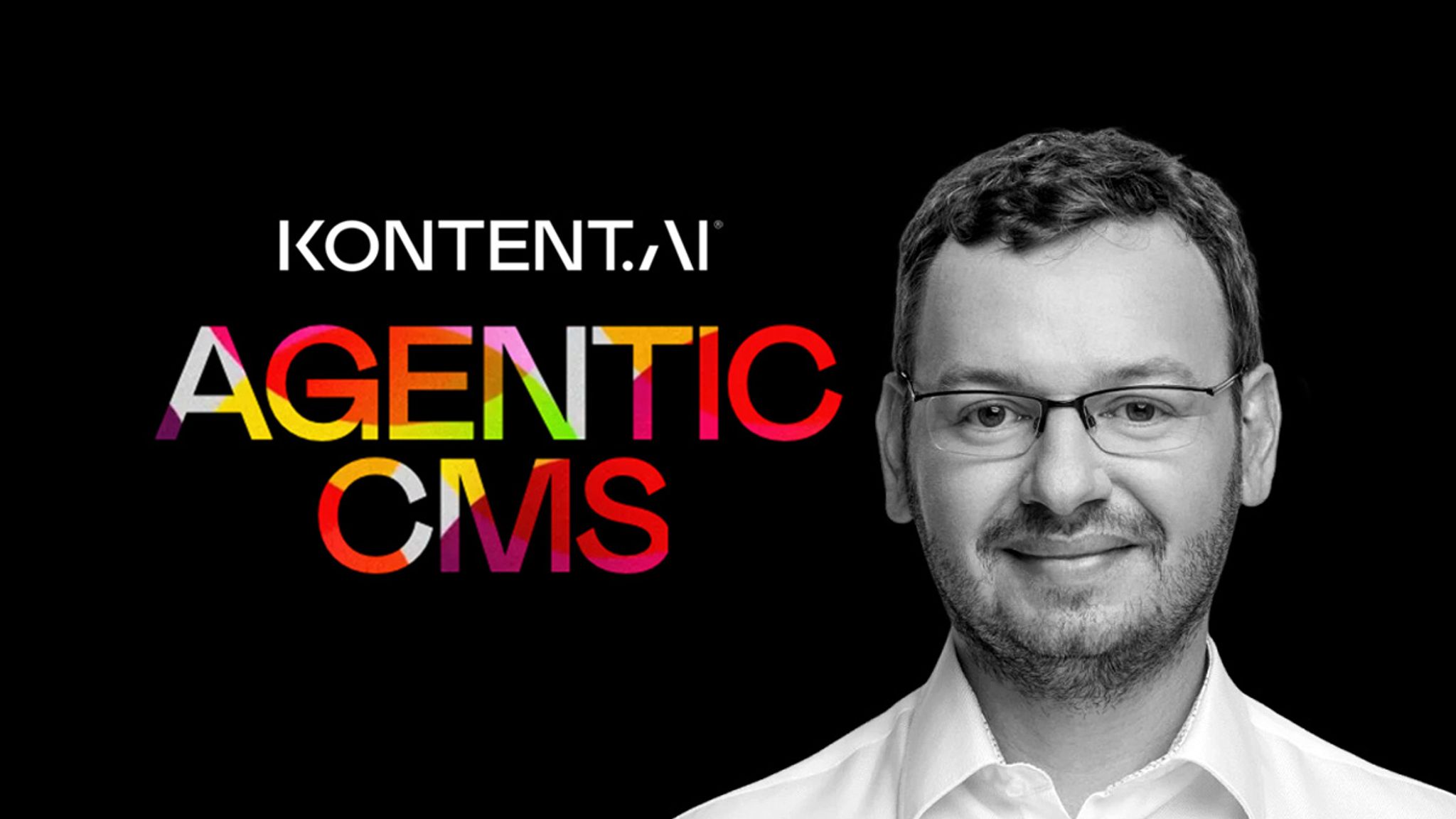
The headless CMS is challenging norms in the agentic era, empowering teams to create without boundaries by automating tedious tasks with intelligent AI agents that provide accelerated performance, stronger governance, and tangible value. Interview with Zbysek Nemec, VP of Engineering.
As an analyst, there are moments when I still pinch myself during a demo. It doesn’t happen often, but advancements in AI have certainly been a catalyst for more awe and wonder.
When I saw Kontent.ai’s example of removing militaristic language from a website in real time with its new Agentic CMS, I felt the hair stand up on the back of my neck.
The whole thing happened while I was facilitating the CMS Idol competition at the Boye & Company CMS Connect 25 conference in Montreal. Like the rest of the attendees in the room, I watched Zbysek Nemec – Kontent.ai’s VP of Engineering – prompt his way through this transformation like butter.
In minutes, Kontent.ai’s agents automagically scanned hundreds of pages on a site, searching for metaphorical terms with a combative or hierarchical slant (think "ambushed by questions" or "army of salespeople”), replacing all of them with appropriate substitutions. In minutes.
This was a pinch-worthy moment. And not just because of the technology or the use case. What got me excited was the elegant dance between humans and agents, automating a task that might have taken weeks of tedious review and manual editing. And it all seemed so frictionless. Effortless. And even fun to watch.
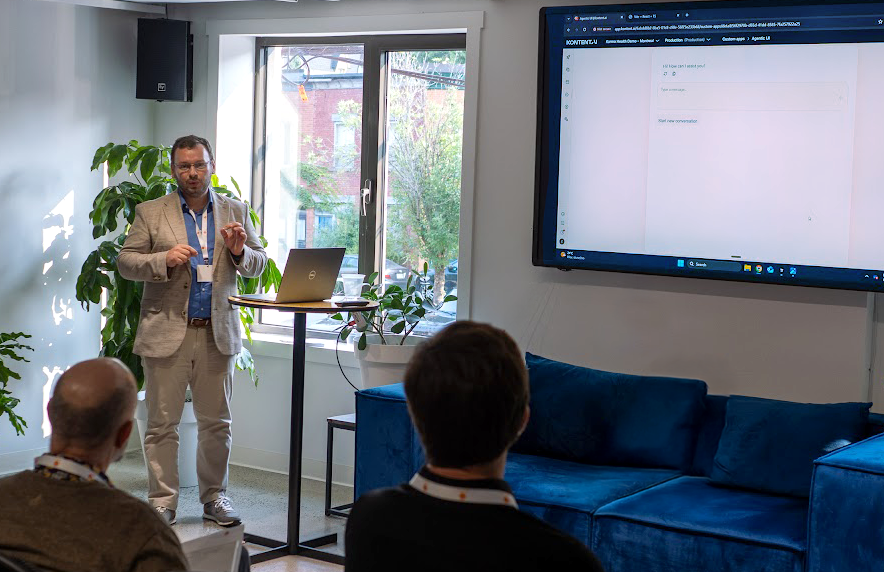
Zbysek Nemec presenting during the “CMS Idol” competition at CMS Connect 25. Source: Janus Boye
While Kontent.ai’s Agentic CMS is in its early stages (it was officially birthed in late June of this year), it’s already gaining traction. When I recently connected with Zbysek, he was more than enthusiastic about the prospects.
“For the next two weeks, I have meetings booked with 20 customers interested in our product,” he said. “I’ve been in the CMS world for the past 18 years, and I’ve never seen so many people so interested. They’re saying, ‘Wow, this is great! How does it scale?’”
That last part about “scale” is the key to all of this. As generative AI has become widely adopted, the sheer volume and complexity of content operations have grown to breathtaking levels. Unfortunately, teams haven’t scaled uniformly to meet the demands. On top of that, marketers and creators are drowning in a tidal wave of tools, stymied by cognitive overload.
But what if you could free up these creators to be more authentic and strategic? When you consider the tasks that marketers could be focusing on – if they were given more time and space – your imagination really kicks in. And for brands, that’s a game-changing proposition that agentic AI can unlock.
Since the latter part of 2022, I’ve seen AI demos from almost every major CMS and DXP vendor, and the applications have run the generative gamut. To say I have “AI fatigue” might be putting it mildly, but this over-exposure has also given me an acute sensitivity to high-utility applications – and Kontent.ai’s vision for Agentic CMS is shooting for the moon.
Of course, “Agentic CMS” is a challenging mantle to claim in a sea of AI sameness. As CMSes and DXPs race to add AI and agent-driven capabilities, there’s a risk that even newer features won’t deliver substantive value. That’s not hyperbole; I’ve spoken to multiple agencies and enterprises over the last year about their AI initiatives, and the ROI has often been elusive.
There’s also been a pervasive fear that AI will displace the valuable role of the content creator, which both agencies and customers have wrestled with. That reality has yet to emerge – and as talk of agents began to permeate the zeitgeist in 2024, the real promise of AI in the DX stack shifted from one of replacing to augmenting the marketer’s contributions.
As a category, CMS has been in a strange state of flux. Vendors are rushing to reposition in the AI gambit, hoping to own more of the agentic story. But Zbysek and his team are forging a decisive roadmap by being pragmatic and value-driven, helping marketers and businesses meet the explosive growth of content by eliminating the bottlenecks between strategy and execution.
Is this the end of CMS as we know it? And is Agentic CMS really the future?
If it is, then Kontent.ai is preparing to take us there.
What is Agentic CMS?
It’s the right question, because the word “agentic” is saturating everything – and it needs context.
Let’s start with the basics: Arguably, CMSes have been lagging in the AI race compared to other industries (just look at healthcare and life sciences). Generative features have been added to CMS platforms somewhat haphazardly over the last few years, but the whole thrust has felt more reactive – and less disruptive.
Agentic CMS aims to solve these issues. It’s an evolutionary step beyond the one-dimensional AI-powered fluff that’s been shoved in or bolted on. It’s a philosophical shift – one where a system is endowed with the ability to think and act alongside your team and have a meaningful impact on your work.
What kind of work? That’s where things get interesting. Imagine a simple, prompt-driven interface free of background limitations, with agents ready to assist a user with everything from designing content structure to ideation to personalization. It also provides enhanced observability over content performance and proactively suggests improvements.
And that’s just scratching the surface.
As Zbysek said, given this sense of domain and responsibility, Agentic CMS becomes less of a tool and more of a partner that helps you carry an impossible load. But there's a distinction in how they've approached it with a CMS-centricity – and at a human level.
“Nowadays, CMS vendors are looking for new ways to frame what they do,” he said. “’Agentic CMS’ means we are focused on the CMS and content management. We’re making the ‘management’ part easier for marketers and content creators. It’s also orchestrating as a system of authority to make connections easier. But it’s a place for people, and we want to empower people to tell their stories and spend less time managing.”
A Roadmap of Agent-Powered Possibilities
One of the biggest benefits of Kontent.ai’s Agentic CMS is the impact on content velocity. With marketers struggling to keep up with demands across a myriad of applications, the wheels of progress can grind to a halt. But with a single prompt, an agent can be tasked with a specific workflow of researching, writing, and publishing SEO-ready content – all within your brand guardrails.
Returning to the example of eliminating militaristic language, Agentic CMS delivers enterprise-wide content governance and the ability to make bulk changes at scale. Agents can scan, audit, and identify violations, provide an organized report for review, and allow users to execute changes without the hassle of manual find-and-replace. Weeks of work are reduced to minutes.
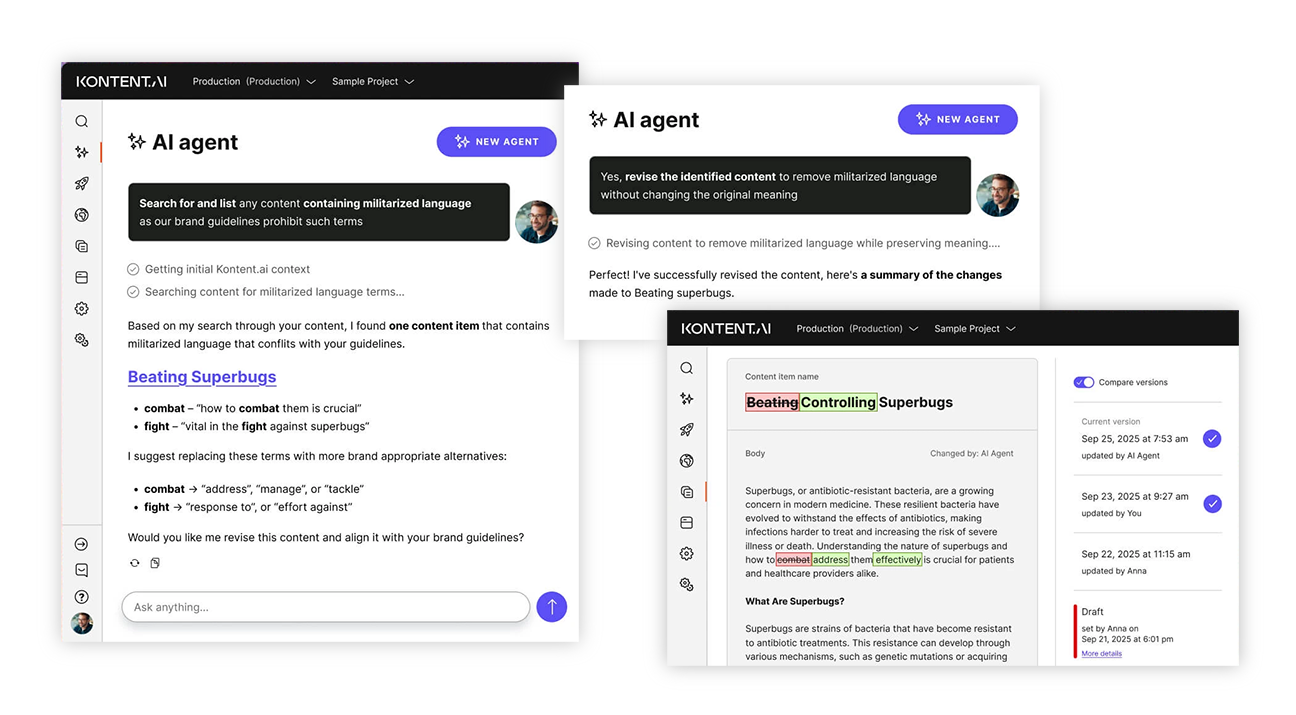
AI Agents can automate content governance at scale with accelerated ease. Source: Kontent.ai website
Translations are another area where the Agentic CMS can have a profound impact on productivity by eliminating reliance on third-party tools and tedious, time-consuming workflows. Now, the CMS handles everything, providing translated content that conforms to your brand voice and standards – and it’s all created instantly.
While content operations is at the heart of its Agentic CMS, Zbysek sees the content strategist as a central role for unleashing its power. Overloaded with responsibilities, these practitioners are still expected to “feed the content machine,” and this is where a new spate of Kontent.ai’s agents will help script and execute a strategy throughout the marketing lifecycle.
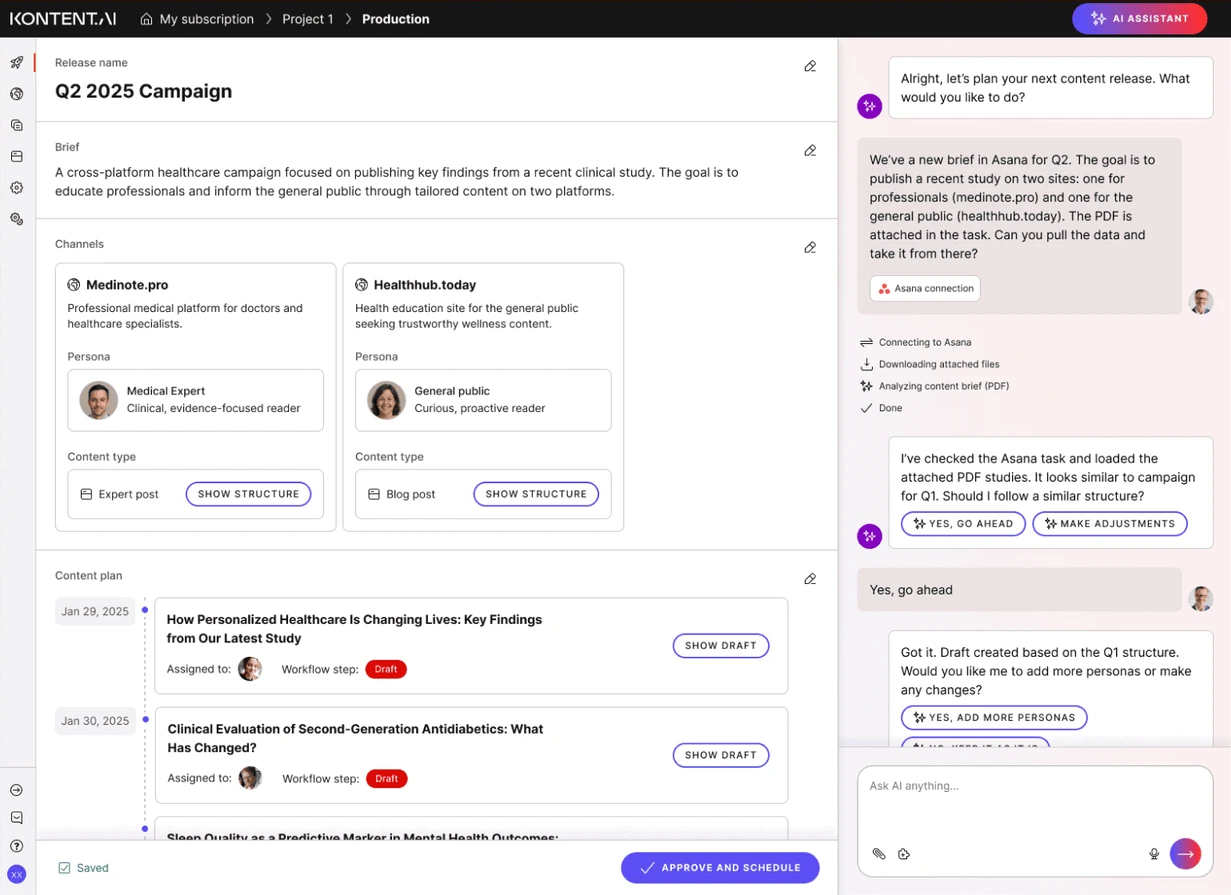
Engaging with Kontent.ai’s Agentic CMS. Source: Kontent.ai website
What will this look like? From a visual perspective, users will have greater observability via an intuitive dashboard, where they can manage their projects at a campaign level with access to briefs, channels, and more – all while engaging with an AI Assistant co-pilot at every step. The goal is to help creators get more work done faster and easier, while feeling like they’re in total control.
From a tactical perspective, users can harness agents to do all kinds of things that once required manual work or, at worst, a development ticket. Agentic CMS eliminates that bottleneck, allowing marketers to shift components on a landing page and create multi-variant tests with natural language prompts.
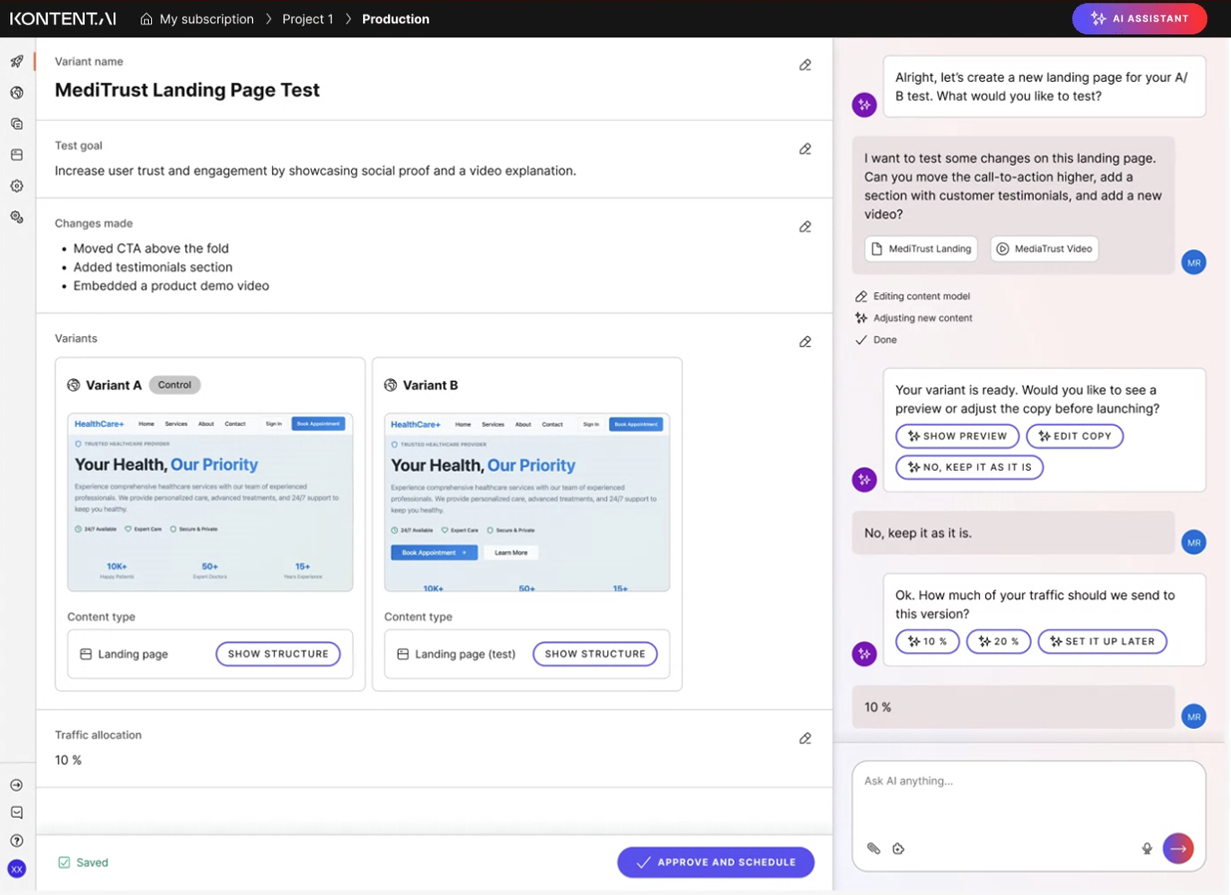
Prompting a multi-variant test on a landing page in Kontent.ai’s Agentic CMS. Source: Kontent.ai
“We have a solution for using content they’ve already created to generate even better content, and ensuring that AI can help to get data to prepare a content plan, synchronize meetings, define the content campaign, and more,” he described. “You feed AI the plan, and it will help define article content components for different channels and assign tasks.”
Agentic CMS is also leveraging both a brand’s content and the layer of metadata above it, allowing its agents to deal with a wider range of problems – from generic to specific – and enable greater accuracy and brand integrity.
LLM choice is becoming a more frequent decision point, and while self-selection isn't a part of the initial release, it's definitely on the roadmap. That said, Agentic CMS does offer some flexibility, leveraging the major models from Anthropic and Microsoft's OpenAI Foundry Models via Azure, which provide mature and reliable performance. Kontent.ai is currently evaluating specialized models that might fit specific verticals like healthcare and compliance.
You can catch Agentic CMS in action below, courtesy of Kontent.ai’s VP of Product, Martin Michalik. Over a hot cup of coffee, he showcases how simple prompts can tackle complex tasks like generating metadata and taxonomies in minutes, all with a layer of human review and approval. He also shows how Agentic CMS can provide SEO insights and recommend improvements, as well as translate, optimize, and schedule language variants – and push it all live safely and securely.
You can pour your own cup of joe, but this might be better than a caffeine buzz:
Launching the Next Wave of Agentic AI with MCP
Model Context Protocol (MCP) has also emerged as a critical standard for connecting AI applications and external systems. Much like a USB connector, it allows different AI tools and systems to connect, talk, and even transact with each other.
With thousands of servers now flooding the ecosystem, MCP is already enabling a host of use cases, providing agent-led connections between an app’s AI interface (chat, for example) and third-party databases or tools like Slack or Salesforce.
To meet this horizon of opportunity, Kontent.ai has already launched its own open source MCP server. With it, users can query Claude to generate a content model in Kontent.ai, or use Cursor to adjust developer-native workflows. Right now, it’s a local server, but Zbysek said they have plans to offer a remote option that will further extend their Agentic CMS across the connected fabric.
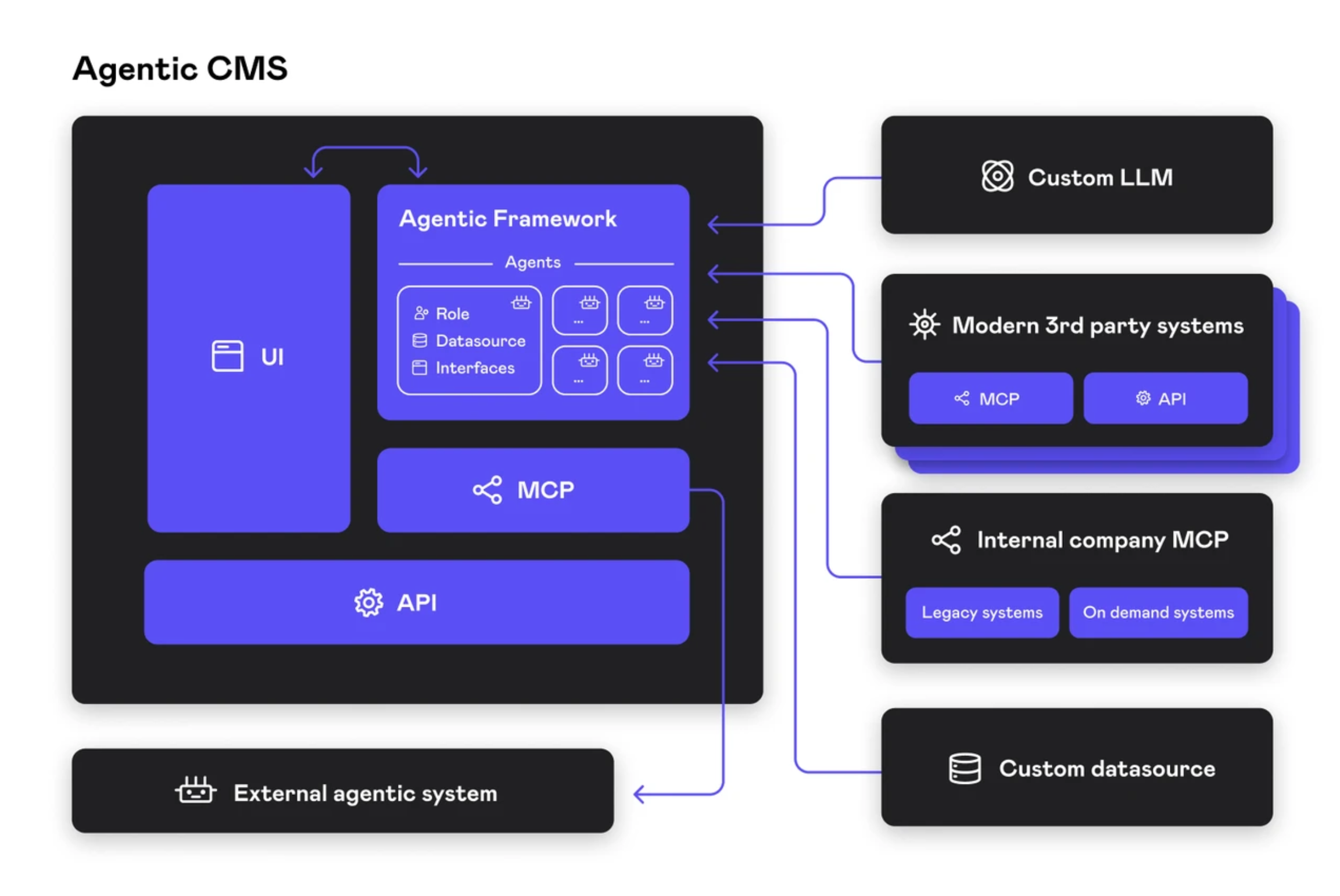
MCP plays a key role in accessing external systems from Kontent.ai's Agentic CMS. Source: Kontent.ai website
When it comes to this bleeding edge of agentic AI, enterprise brands have been leading the charge with MCP adoption. That said, MCP also has its own nest of security risks, from prompt injection to tool poisoning, so it requires monitoring and routine validation. This is why you need trusted vendors to back it up.
According to Zbysek, roughly five to ten percent of their customers have the “AI maturity” to handle all the variables and move in this direction. But he expects that number to grow.
“MCP will enable us to interact with other systems and different MCP clients,” he explained. “Maybe you’re using Asana or Monday for tasks, but soon we'll be able to have agents pull tasks by accessing those systems and have them create the content you’re tasked with. The possibilities are so much bigger.”
Eventually, this will open up pathways for agent-to-agent interactions, which will enable even greater automation across different tools and applications. This is why having a modern CMS with native agentic capabilities will be essential for navigating this evolution.
Building on an AI legacy
For Kontent.ai, which was one of the first CMSes to launch native AI capabilities, artificial intelligence has always been part of its DNA (they did make it part of their name). Since it was spun from Kentico’s sandbox in 2022 – raising $40 million in capital to power its entry into the category – it has championed fluent content creation with GDPR compliance, taking an early stake in the critical role of governance and privacy in AI.
Zbysek told me about the genesis of Agentic CMS, which was built on this pioneering heritage. As he noted, getting to a truly disruptive place required deep exploration, reflection, and a certain frankness about the industry’s rampant commoditization.
“I don’t know many users who love their CMS,” he said, laughing. “When we first started thinking about the idea of an Agentic CMS, we looked at our market. There are new and established vendors, and we’ve all been doing the same thing over the last 20 years. We can focus on the technical aspects, but then there’s a big gap for the businesses. It’s been a back-and-forth, so we really focused in on how AI can make things easier for users.”
“Our users want to be creative. What they fight with are the difficulties of the rules. The length of time to connect with customers. We wanted to focus on making that part of it better.”
I wrote about the “race to the middle” as traditional CMS vendors added headless offerings and monolithic DXPs deconstructed into composable ecosystems. While the battle was waging, little was done to advance the core layer of CMS, and the parity around products created confusion and frustration.
Then came a crop of vanilla AI creation tools, and everyone jumped on the bandwagon. But very little progress was made in addressing the root challenge of managing complex content operations with speed and scale. Those early chapters of generative AI forced a reckoning with value, and some vendors are reassessing their AI strategies and how their innovation is helping – not hurting – both editors and customers.
“Our users want to be creative,” Zbysek said. “What they fight with are the difficulties of the rules. The length of time to connect with customers. We wanted to focus on making that part of it better.”
Leveraging the headless advantage
Composability has also been a key ingredient in the “AI secret sauce.” Being headless has presented opportunities but also challenges, particularly with creatives.
“Frankly, when we started Kontent.ai three years ago, it was less about what [marketing] people wanted,” Zbysek said, reflecting how headless CMSes struggled with the gap around visual editing. He said most of their customers are now arriving at a mature place in the decision process, and some are even aware of how a headless architecture can be an asset for AI.
For enterprises with legacy systems, the move to a modern system will be essential for agentic strategies. At “The Composable Conference” in April, I ran into multiple enterprises that were still on a 25-year-old, home-grown CMS that was replete with problems. Zbysek sees this regularly and reinforced how it’s a blocker for agentic transformation.
There are also legacy industries like healthcare and finance – which Kontent.ai is very focused on – where assets like PDFs have created a wall for accessing digital content. But this is where Kontent.ai’s Agentic CMS can do wonders with a composable framework.
“Not long ago, we were all saying how the age of digital transformation is over, but many companies are ‘somewhat digital’ in a strange way that’s not really helping them from a business perspective,” he said. “What we’re working with from a composable approach is to make all of those assets searchable and discoverable and then use them as sources for agents to turn into a structured format to create articles, papers, and other assets.”
Leading Agentic transformation through education
Change is hard. And being a disruptor is an order and magnitude more difficult in a category like CMS. But as Zbysek said, the industry is ripe for change – and he believes this is the moment.
To that end, he and Martin Michalik have been evangelizing the progress and visionary roadmap of Agentic CMS. This includes conference demos and forums, but it’s also tapping Kontent.ai’s channel of agencies and SIs. The goal is to multiply the benefits of Agentic CMS among builders and customers and use thought leadership as a conduit.
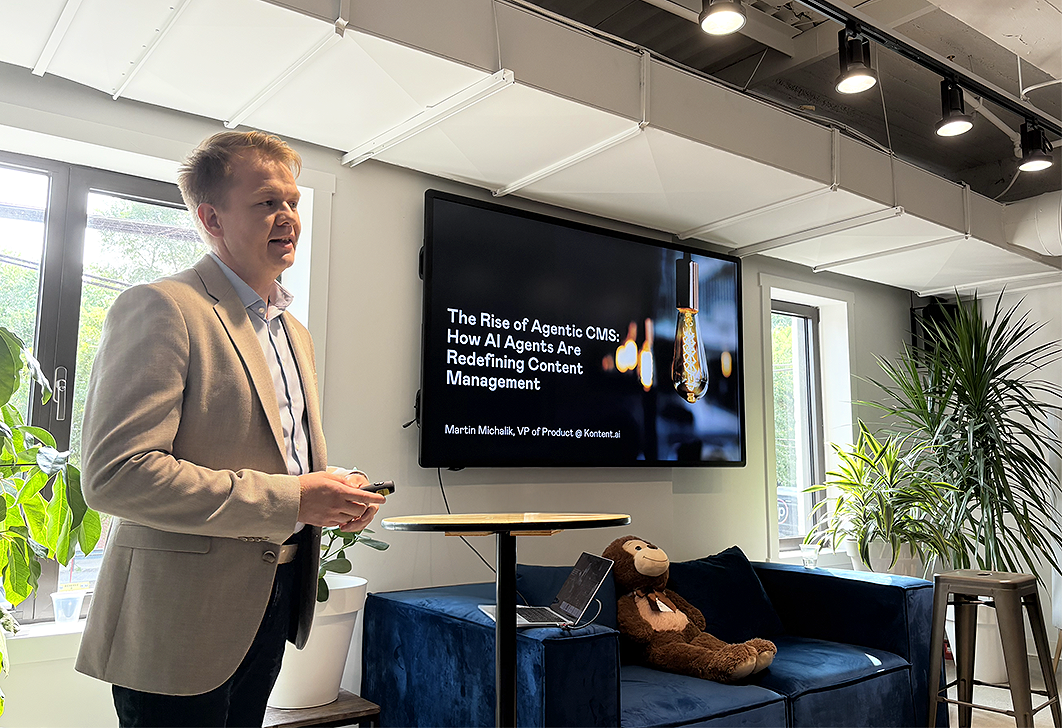
Kontent.ai’s Martin Michalik presenting at CMS Connect 25. Source: Janus Boye
“Right now, we’ve started with partner education,” Zbysek said. “We should have the first partner talking about Agentic CMS very soon. But we’re also focused on connecting with end customers, as many have their own engineering teams and a CMS that they’re looking to move off of.”
As a product company, Kontent.ai backs up its performance with dedicated professional services, which will now be instrumental in realizing agentic transformation. The company already has an established set of Customer Success Services, which provide support throughout the adoption journey.
This includes some of Kontent.ai’s traditional e-learning, but also covers a human CSM to monitor progress and explore new capabilities. One example: How AI can help streamline the challenges of transferring data in a migration process.
As Zbysek said, Kontent.ai’s Customer Success Services will be a launchpad for making Agentic CMS a success as organizations embrace this new paradigm in content operations.
“We have social architects on our team, and we start with a framework to determine the maturity of the customer, where data is, how we’re importing it, even helping with content modeling,” he explained. “This one practical aspect that most large companies just aren’t good at is how do we future-proof and approach things. We’re guiding them through that process.”
The Verdict: Is Agentic CMS the future?
The short answer is yes. Much in the same way that headless and composable were about flexibility, agentic is about intelligence and autonomy – and it represents the next logical evolution towards adaptivity, productivity, and simplicity.
That said, we’re still in the early stages of the agentic race. And while the noise level is increasing, Kontent.ai is cutting through by solving real-world problems. Their vision for Agentic CMS is guided by targeted value, where agents are augmenting the human resources of a marketing team, reducing dependency on technical resources, and helping content strategists create and execute at scale.
Agentic CMS won’t replace our current systems overnight, but the seeds have been planted. In a market where vendors are striving to differentiate their AI positioning, I think it’s sage to augment the foundational role of CMS. Many platforms have packaged themselves as a DXP (or a new derivative), but Kontent.ai is doubling down on CMS as the core, and that could help reduce confusion and streamline adoption. It’s also giving them a competitive narrative that could resonate more easily with buyers.
From a technical and feature standpoint, Kontent.ai’s roadmap for Agentic CMS looks solid. Zbysek and team have thoughtfully approached the UX like seasoned CMS engineers, and the tool already provides an elegant, intuitive experience that focuses on cleanly on optimization. The investment in MCP is also providing a future-proof gateway to an expanded ecosystem of possibilities. Overall, the use cases are compelling and worthy of a demo.
Of course, there are challenges. The maturity gap for one, but also the integration debt inherited around complex martech stacks. But this is where Kontent.ai is rolling out the red carpet with human support, providing smart people and processes to ensure that existing tools, data, and workflows can make the leap to Agentic CMS – and confidently ensure brand voice, compliance, and accuracy.
There’s one other area that warrants consideration: change management. As CMS evolves to an agentic state, teams that are accustomed to more hands-on control will need to reorient around the automated impact on content operations. Zbysek believes education is the key to activating this, and Kontent.ai is investing in that knowledge transfer.
“CMS is evolving, but how will it look in 10 to 15 years?” he asked. “That is the future, but until then, we need to help customers understand AI.”
Agentic CMS is technology. And it might make the hair stand up on your neck. But the real story is about people. Helping customers embrace change is how you own the future, and that’s exactly what Kontent.ai is doing – and why their vision is inspiring.
To learn more about Kontent.ai's Agentic CMS, or to join the waitlist, click here.
Upcoming Events

Storyblok JoyConf 2025
October 14-15, 2025 – Amsterdam, Netherlands
November 4, 2025 – New York, NY
November 6, 2025 – Los Angeles, CA
Join us at JoyConf 2025, where the future of content meets the people shaping it. Built for developers, marketers, and digital innovators, this free conference goes way beyond product updates or yet another strategy playbook. It’s where you’ll get inspired, get real, and get connected – to ideas, to the community, and to what’s possible when you build joyfully. Whether you're building lightning-fast frontends or launching cross-channel campaigns, this is where content becomes connection and collaboration becomes second nature. Come for the talks. Stay for the community. Leave with joy. Save your spot.

Sitecore Symposium 2025
November 3-5, 2025 – Orlando, FL
At Sitecore Symposium, you’ll learn how to meet your customers where they are – across channels, moments, and touchpoints that didn’t exist a year ago. You’ll hear how the boldest brands in the world are transforming content into outcomes and creating experiences that are fast, relevant, and human. Join 1,500 marketers, digital leaders, and technologists in Orlando to see what’s possible when personalization scales, AI accelerates creativity, and trust becomes your competitive edge. This is the Third Wave of the Internet. And this is your moment to lead in it. Get your tickets today.
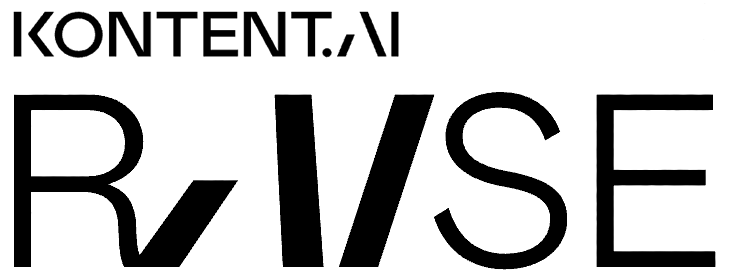
RAISE: Lifting Content into the Future with Agentic CMS
November 11, 2025 – London, UK
Join Kontent.ai at RAISE: Lifting Content into the Future with Agentic CMS, a premier free event for forward-thinking marketing and technology leaders shaping the way today’s most ambitious brands create and deliver content. Expect bold ideas, discover innovative strategies, engage with industry leaders, and gain insights that will lift your content strategy to new heights. At RAISE, you'll learn how to deliver faster, more engaging content experiences while AI does the busywork of audits, compliance, and localization with Agentic CMS, built to give you and your teams more time on creativity that matters. Reserve your seat today.

CMS Kickoff 2026
January 13-14, 2026 – St. Petersburg, FL
Meet industry leaders at our fourth annual CMS Kickoff – the industry's premier global CMS event. Similar to a traditional kickoff, we reflect on recent trends and share stories from the frontlines. Additionally, we will delve into the current happenings and shed light on the future. Prepare for an unparalleled in-person CMS conference experience that will equip you to move things forward. This is an exclusive event – space is limited, so secure your tickets today.